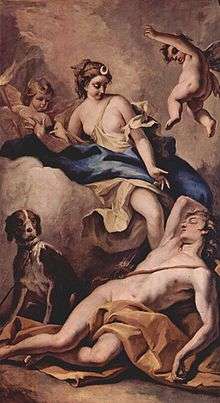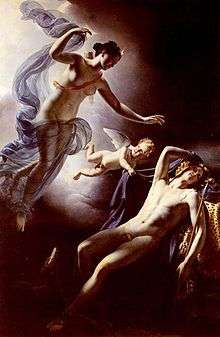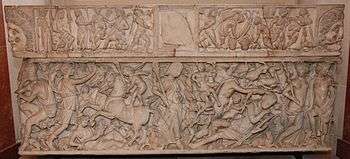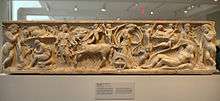Endymion (mythology)
In Greek mythology, Endymion[lower-alpha 1] (/ɛnˈdɪmiən/; Ancient Greek: Ἐνδυμίων, gen.: Ἐνδυμίωνος) was variously a handsome Aeolian shepherd, hunter, or king who was said to rule and live at Olympia in Elis.[1] He was also venerated and said to reside on Mount Latmus in Caria, on the west coast of Asia Minor.[2]

There is confusion over Endymion's correct identity, as some sources suppose that he was, or was related to, the prince of Elis, and others suggest he was a shepherd from Caria. There is a later suggestion that he was an astronomer: Pliny the Elder[3] mentions Endymion as the first human to observe the movements of the moon, which (according to Pliny) accounts for Endymion's love. Consequently, there have been two attributed sites of Endymion's burial: the citizens of Heracleia ad Latmo claimed that Endymion's tomb was on Mount Latmus, while the Eleans declared that it was at Olympia.[4]
However, the role of lover of Selene, the moon, is attributed primarily to Endymion who was either a shepherd or an astronomer, either profession providing justification for him to spend time beneath the moon.
Mythology


Apollonius of Rhodes[5] is one of the many poets[6] who tell how Selene, the Titan goddess of the moon,[lower-alpha 2] loved the mortal Endymion. She believed him to be so beautiful that she asked Endymion's father, Zeus, to grant him eternal youth so that he would never leave her. Alternatively, Selene so loved how Endymion looked when he was asleep in the cave on Mount Latmus, near Miletus in Caria,[7] that she entreated Zeus that he might remain that way. In some versions, Zeus wanted to punish Endymion for daring to show romantic interest in Hera (much like Ixion). Whatever the case, Zeus granted Selene's wish and put Endymion into an eternal sleep. Every night, Selene visited him where he slept, and by him had fifty daughters who are equated by some scholars with the fifty months of the Olympiad.[8]
According to a passage in Deipnosophistae, the sophist and dithyrambic poet Licymnius of Chios[9] tells a different tale, in which Hypnos, the god of sleep, in awe of his beauty, causes him to sleep with his eyes open, so he can fully admire his face.
The Bibliotheke claims that:
- "Calyce and Aethlius had a son Endymion who led Aeolians from Thessaly and founded Elis. But some say that he was a son of Zeus. As he was of unsurpassed beauty, the Moon fell in love with him, and Zeus allowed him to choose what he would, and he chose to sleep for ever, remaining deathless and ageless. Endymion had by a Naiad nymph or, as some say, by Iphianassa, a son Aetolus, who slew Apis, son of Phoroneus, and fled to the Curetian country. There he killed his hosts, Dorus and Laodocus and Polypoetes, the sons of Phthia and Apollo, and called the country Aetolia after himself."[10]
According to Pausanias, Endymion deposed Clymenus, son of Cardys, at Olympia.[11] Describing the "early history" of the Eleans, Pausanias reports that:
- "The first to rule in this land, they say, was Aethlius, who was the son of Zeus and of Protogeneia, the daughter of Deucalion, and the father of Endymion. The Moon, they say, fell in love with this Endymion and bore him fifty daughters. Others with greater probability say that Endymion took a wife Asterodia—others say she was Chromia, the daughter of Itonus, the son of Amphictyon; others again, Hyperippe, the daughter of Arcas—but all agree that Endymion begat Paeon, Epeius, Aetolus, and also a daughter Eurycyda. Endymion set his sons to run a race at Olympia for the throne; Epeius won, and obtained the kingdom, and his subjects were then named Epeans for the first time. Of his brothers they say that Aetolus remained at home, while Paeon, vexed at his defeat, went into the farthest exile possible, and that the region beyond the river Axius was named after him Paeonia. As to the death of Endymion, the people of Heracleia near Miletus do not agree with the Eleans for while the Eleans show a tomb of Endymion, the folk of Heracleia say that he retired to Mount Latmus and give him honor, there being a shrine of Endymion on Latmus.[12]
Pausanias also reports seeing a statue of Endymion in the treasury of Metapontines at Olympia.[13]
Propertius (Book 2, el. 15), Cicero's Tusculanae Quaestiones (Book 1), and Theocritus discuss the Endymion myth to some length, but reiterate the above to varying degrees. The myth surrounding Endymion has been expanded and reworked during the modern period by figures like Henry Wadsworth Longfellow and John Keats in his 1818 narrative poem Endymion.
| Relation | Names | Sources | |||||||
|---|---|---|---|---|---|---|---|---|---|
| Hesiod | Conon | Apollodorus | Pausanias | Nonnus | Clement | Stephanus | |||
| Parents | Aethlius and Calyce | ✓ | ✓ | ||||||
| Aethlius | ✓ | ||||||||
| Aethnos | ✓ | ||||||||
| Zeus | ✓ | ||||||||
| Zeus and Phoenissa | ✓ | ||||||||
| Wife | Naiad nymph | ✓ | |||||||
| Iphianassa | ✓ | ||||||||
| Selene | ✓ | ✓ | |||||||
| Asterodia | ✓ | ||||||||
| Cromia | ✓ | ||||||||
| Hyperippe | ✓ | ||||||||
| Children | Aetolus | ✓ | ✓ | ✓ | |||||
| Eurypyle | ✓ | ||||||||
| 50 daughters | ✓ | ||||||||
| Eurycyda | ✓ | ||||||||
| Epeius | ✓ | ||||||||
| Paeon | ✓ | ||||||||
| Narcissus | ✓ | ||||||||
| Naxos | ✓ | ||||||||
Background


No explicit narrative has survived. In Argonautica (iv.57ff) the "daughter of Titan," the Moon, was witness to Medea's fearful night-time flight to Jason, and "rejoiced with malicious pleasure as she reflected to herself: 'I'm not the only one then to skulk off to the Latmian cave, nor is it only I that burn with desire for fair Endymion'" she muses. "But now you yourself it would seem, are a victim of a madness like mine."[14] Lemprière's Classical Dictionary reinforces Pliny's account of Endymion's attachment to astronomy and cites it as the source of why Endymion was said to have a relationship with the moon as she passed by.

The mytheme of Endymion being not dead but endlessly asleep, which was proverbial (the proverb—Endymionis somnum dormire, "to sleep the sleep of Endymion")[16] ensured that scenes of Endymion and Selene were popular subjects for sculpted sarcophagi in Late Antiquity, when after-death existence began to be a heightened concern. The Louvre example, discovered at Saint-Médard-d'Eyrans, France (illustration above), is one of this class.
Some believe that he was the personification of sleep, or the sunset (most likely the last one as his name, if it were Greek rather than Carian can be construed from "to dive in" [Greek en (ἐν) in, and duein (δύειν) dive], which would imply a representation of that sort. Latin writers explained the name from somnum ei inductum, the "sleep put upon him".[17]
The myth of Endymion was never easily transferred to ever-chaste Artemis, the Olympian associated with the Moon.[18] In the Renaissance, the revived moon goddess Diana had the Endymion myth attached to her.
Notes
- Michael Drayton's spelling in Endimion and Phœbe (1597) did not catch on.
- Her Roman equivalent is Luna.
Citations
- Classical sources linking Endymion with Elis include Pausanias, 5.1.3 & Pseudo-Apollodorus. Bibliotheca, 1.7.5-6
- Classical sources linking Endymion with Mount Latmus include Ovid, Heroides, xviii.61–65; Ovid, Ars Amatoria, iii.83; Lucian, Dialogi deorum, 19, where Endymion is discussed by Aphrodite and Selene; Cicero, Tusculan Disputations i.38.92.
- Pliny's Naturalis Historia Book II.IV.43.
- John Lemprière's Classical Dictionary
- Argonautica 4.57ff.
- Compare Plato, Phaedo 72c.
- Sappho localises the myth at Mount Latmus.
- Pausanias 5.1.4, J. Davidson, "Time and Greek Religion", in A Companion to Greek Religion, edited by D. Ogden (John Wiley & Sons, 2010) ISBN 978-1-44433417-3, pp. 204–5.
- Licymnius is known only through a few quoted lines and second-hand through references (William Smith, ed. Dictionary of Greek and Roman Antiquities 1870 Archived 2007-04-05 at the Wayback Machine)
- Pseudo-Apollodorus. Bibliotheca, 1.7.5-6
- Pausanias, 5.8.1.
- Pausanias, 5.3–5.
- Pausanias, 6.19.11.
- Richard Hunter, Apollonius of Rhodes: Jason and the Golden Fleece (Oxford University Press) 1993:100.
- Accession Number 24.97.13.
- Described in Sir James George Frazer, ed., Apollodorus, Library and Epitome .
- Graves, 1960, 64 note 2.
- Hyginus (Fabula 271) identifies Endymion as he "whom Luna loved", keeping the necessary moon connection but avoiding Diana.
References
- Apollodorus. Apollodorus, The Library, with an English Translation by Sir James George Frazer, F.B.A., F.R.S. in 2 Volumes. Cambridge, MA, Harvard University Press; London, William Heinemann 1921.
- Robert Graves. The Greek Myths (1955) 1960, 64 a-c.
- Pausanias, Description of Greece. W.H.S. Jones (translator). Loeb Classical Library. Cambridge, MA: Harvard University Press; London, William Heinemann (1918). Vol. 1. Books I–II: ISBN 0-674-99104-4.
- Plato. Plato in Twelve Volumes, Vol. 1 translated by Harold North Fowler; introduction by W.R.M. Lamb. Cambridge, MA, Harvard University Press; London, William Heinemann 1966.
- Karl Kerenyi. The Gods of the Greeks. London: Thames & Hudson, 1951 (pp. 196–98).
- Hyginus. Fabulae, 271.
- Natalia Agapiou. "Endymion at the Crossroads: The Fortune of the Myth of Endymion at the Dawn of the Modern Era", in Res Publica Litterarum: Studies in the Classical Tradition, 27/7 (2004), p. 70-82.
- Natalia Agapiou. Endymion au carrefour. La fortune littéraire et artistique du mythe d’Endymion à l’aube de l’ère moderne (Berlin, 2005): ISBN 978-3-7861-2499-3.
External links
| Wikimedia Commons has media related to Endymion. |
- Unknown author (November 1999). "Diana and Endymion circa 1700- 1730, by Francesco Solimena (1657-1747)". Artwork of the Month. National Museums Liverpool: Walker Art Gallery. Retrieved 2008-02-24.
- For works by Gerard de Lairesse, Frans Floris, in RKD (The Hague) and Bildindex (Marburg), see the; et al. "Iconclass Browser".CS1 maint: multiple names: authors list (link)

- Diana and Endymion painting by Pierre Subleyras (c. 1740)